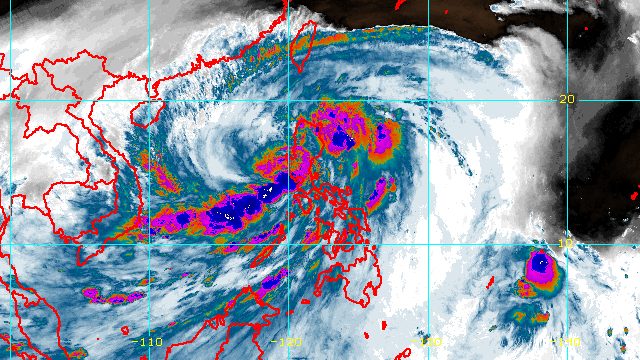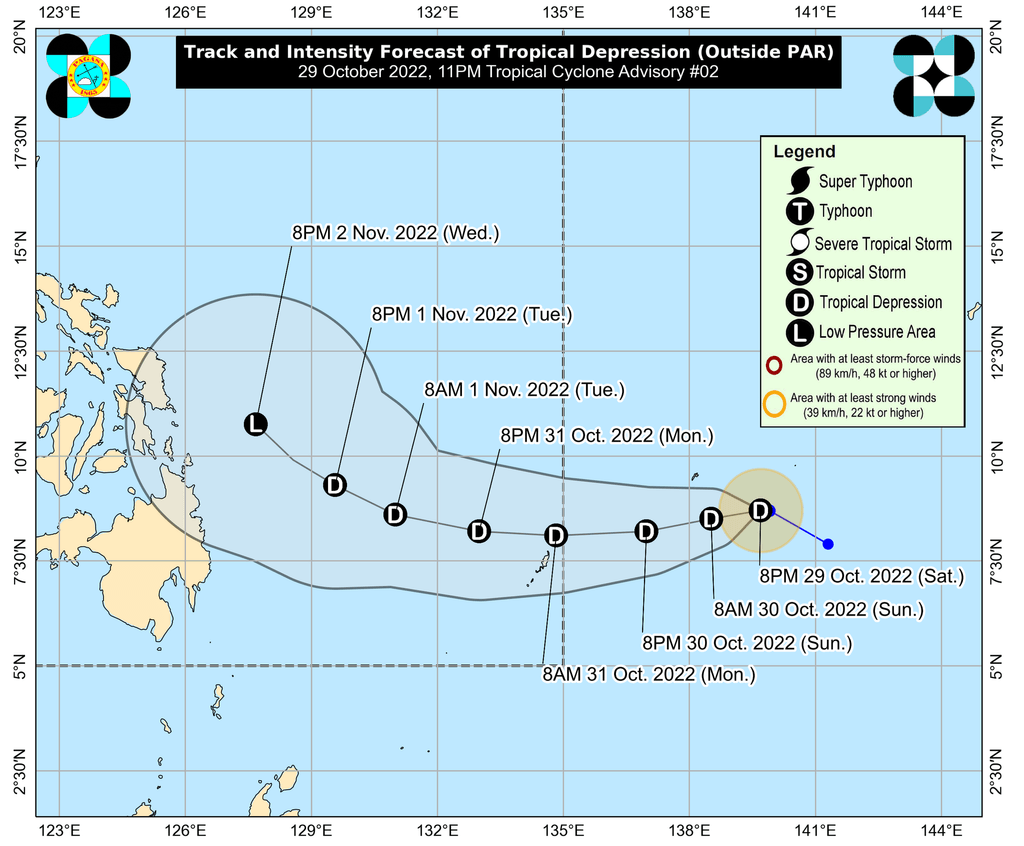SUMMARY
This is AI generated summarization, which may have errors. For context, always refer to the full article.

MANILA, Philippines – Paeng (Nalgae) weakened from a severe tropical storm into a tropical storm as it was about to exit the landmass of Luzon in the early hours of Sunday, October 30.
Paeng’s maximum sustained winds decreased from 95 kilometers per hour to 85 km/h, said the Philippine Atmospheric, Geophysical, and Astronomical Services Administration (PAGASA) in its 2 am bulletin on Sunday. The tropical storm’s gustiness went down from 160 km/h to 140 km/h.
But PAGASA said Paeng is expected to re-intensify into a severe tropical storm when it is already over the West Philippine Sea.
Paeng was last spotted in the vicinity of Candelaria, Zambales, moving northwest at a faster 25 km/h from the previous 15 km/h.
It is seen to exit the Philippine Area of Responsibility (PAR) on Monday morning or afternoon, October 31.
Though Paeng is leaving landmass, PAGASA warned that it may still cause rain until Sunday morning, particularly in these areas:
Heavy to intense rain
- Zambales
- Bataan
- northern part of mainland Cagayan
Moderate to heavy rain
- rest of mainland Cagayan Valley
- Cordillera Administrative Region
- rest of Central Luzon
- Pangasinan
Light to moderate rain, with at times heavy rain
- rest of Luzon
- Western Visayas
The weather bureau said floods and landslides remain expected.
Since Paeng has been downgraded to a tropical storm, there are no more areas under Signal No. 3 as of 2 am on Sunday. Signal Nos. 1 and 2 are still in effect.
Signal No. 2
Gale-force winds (62 to 88 km/h), minor to moderate threat to life and property
- Pangasinan
- La Union
- southern part of Ilocos Sur (Candon City, Banayoyo, Galimuyod, Sigay, Suyo, Santa Lucia, Santa Cruz, Alilem, Tagudin, Sugpon, Cervantes, Quirino, Gregorio del Pilar, Salcedo, Lidlidda, San Emilio, Santiago, Burgos, Santa Maria, San Esteban)
- Benguet
- western and southern parts of Nueva Vizcaya (Kayapa, Aritao, Santa Fe, Dupax del Sur, Alfonso Castañeda, Bambang, Dupax del Norte, Ambaguio, Bayombong)
- southern part of Aurora (San Luis, Baler, Dingalan, Maria Aurora)
- Nueva Ecija
- Zambales
- Tarlac
- Pampanga
- Bulacan
- Bataan
- Metro Manila
- northeastern and western parts of Laguna (Mabitac, Cabuyao City, San Pedro City, Calamba City, Pangil, Santa Maria, Siniloan, Biñan City, Santa Rosa City, Famy, Pakil)
- northwestern part of Batangas (Nasugbu)
- Rizal
- Cavite
- northern part of mainland Quezon (General Nakar, Infanta)
Signal No. 1
Strong winds (39 to 61 km/h), minimal to minor threat to life and property
- Cagayan including Babuyan Islands
- Isabela
- Quirino
- rest of Nueva Vizcaya
- Apayao
- Kalinga
- Abra
- Ifugao
- Mountain Province
- Ilocos Norte
- rest of Ilocos Sur
- rest of Aurora
- rest of Batangas
- rest of Quezon including Polillo Islands
- rest of Laguna
- Marinduque
- Occidental Mindoro including Lubang Islands
- Oriental Mindoro
- Calamian Islands
- Romblon
- Camarines Norte
- Camarines Sur
- western part of Albay (Polangui, Libon, Tiwi, Malinao, Oas)
- Burias Island
- Caluya Islands
PAGASA added that Paeng’s outer circulation and the surge of the northeast monsoon or hanging amihan will bring gusty conditions to the rest of Luzon and Western Visayas, especially in coastal and mountainous areas.

There is still a minimal risk of storm surges up to 2 meters high, which may cause floods in the “low-lying and exposed coastal areas” of the following:
- Zambales
- western part of Bataan
- western part of Pangasinan
Meanwhile, the gale warning issued at 5 pm on Saturday, October 29, remains in effect.
- seaboards of Central Luzon and Southern Luzon and western seaboard of Northern Luzon (Aurora, Zambales, Bataan, Pampanga, Bulacan, Metro Manila, Cavite, Batangas, Quezon including Polillo Islands, Occidental Mindoro including Lubang Islands, Oriental Mindoro, Marinduque, Romblon, Camarines Norte, Camarines Sur, Catanduanes, Albay, Sorsogon, Masbate including Burias and Ticao Islands, Ilocos Norte, Ilocos Sur, La Union, Pangasinan) – very rough to high seas, waves 4.5 to 8 meters high
- northern and eastern seaboards of Northern Luzon (Batanes, Cagayan including Babuyan Islands, Isabela) – very rough seas, waves 4.5 to 6 meters high
- seaboards of Visayas and Palawan (Aklan, Antique, Capiz, Iloilo, Guimaras, Negros Occidental, Negros Oriental, Cebu, Bohol, Siquijor, Northern Samar, Samar, Eastern Samar, Biliran, Palawan including Calamian, Cuyo, Cagayancillo, and Kalayaan Islands) – rough to very rough seas, waves 4 to 5.5 meters high
- eastern seaboards of Visayas and Mindanao (Leyte, Southern Leyte, Surigao del Norte including Siargao and Bucas Grande Islands, Dinagat Islands, Surigao del Sur, eastern coast of Davao Oriental) – rough to very rough seas, waves 2.8 to 4.5 meters high
“Rough to high sea conditions are risky for all types of sea vessels. Mariners are advised to remain in port or take shelter in port until winds and waves subside,” PAGASA said.
Paeng is the Philippines’ 16th tropical cyclone for 2022 and the fourth for October.
It made landfall five times, all on Saturday:
- Virac, Catanduanes – 1:10 am
- Caramoan, Camarines Sur – 1:40 am
- Buenavista, Quezon – 6 am
- Santa Cruz, Marinduque – 8:40 am
- Sariaya, Quezon – 1:40 pm
After hitting Quezon for a second time, Paeng crossed Laguna, Cavite, the Metro Manila-Rizal-Bulacan area, Pampanga, and Zambales.
Even before its landfalls in Luzon, Paeng already wreaked havoc in parts of Mindanao and the Visayas.
Aside from Paeng, the weather bureau is monitoring a tropical depression outside PAR.
The tropical depression was located 1,440 kilometers east of northeastern Mindanao on Saturday evening, almost stationary or barely moving.
It still has maximum sustained winds of 45 km/h and gustiness of up to 55 km/h.
PAGASA said the tropical depression may enter PAR on Monday, and would be given the local name Queenie.
It is projected to remain a tropical depression until Tuesday, November 1, and may weaken into a remnant low on Wednesday, November 2. This means it is unlikely to directly affect the country.

– Rappler.com
Add a comment
How does this make you feel?





There are no comments yet. Add your comment to start the conversation.